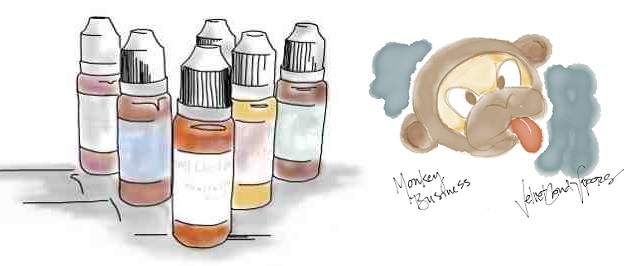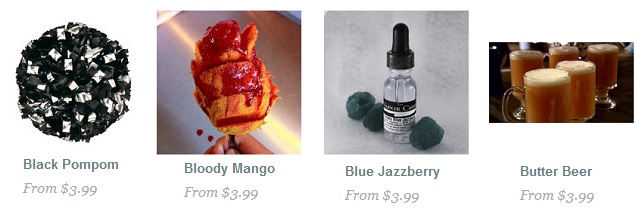
E-liquids are the part of vaping that we enjoy. We collect devices and atomizers with the intent of increasing our enjoyment of our e-liquids, and so it only makes sense that the art of crafting the perfect e-liquid is becoming more and more important. From the early days of enjoyable but fairly straightforward flavors (the sort of thing you find in pre-filled cartomizers) the world of e-liquid has matured like a fine wine.
Now, companies like The Vapor Chef, Namber Juice, Five Pawns and Velvet Cloud Vapor offer ranges of “gourmet” e-liquid, complete with complex, carefully balanced and exotic flavors and borderline pornographic descriptions. But is it all hot air? Five Pawns’ Castle Long Reserve, for example, is available for limited periods each year at a price of $37.50 for 30 ml ($1.25 per ml) – is it ever really worth paying that much for a bottle of juice?
Ordinary vs. Gourmet E-Liquids
This is a bit of a presumptuous distinction to draw, but let’s class most e-liquid producers as “ordinary.” This isn’t intended as a criticism – because there are some excellent juice vendors that would fall into this category – but more of a statement about the type of things on offer and what they present themselves as. For example, browsing the e-liquids available at Mt. Baker Vapor shows a selection of flavors such as blueberry, cookies and cream, dragonfruit and vanilla cupcake. Although these are fairly interesting flavors, they’re pretty bluntly described as what they are – it’s no-frills replications of sweets and fruits you’ll encounter in day to day life. The same goes for tobaccos, which are generally modeled on well-known tobaccos for obvious reasons.
Compare this with the menu of the Vapor Chef.

For one, it’s called a menu. It has flavors like apple bourbon tobacco, champagne and strawberries, and a combination of peanut butter, banana and toasted marshmallows. The descriptions are fanciful, like this one for Slartibartfast:
A complex tobacco, notes of oak and cherry with a slight hint of vanilla. This tastes like the tobacco shops I used to walk into as a child with my father. The smell of the fresh cherry pipe tobacco right when they opened that big glass jar to scoop some into a bag. That's what this tastes like.
It’s this different relationship with flavor that separates “gourmet” e-liquid from what we’re (unfairly) referring to as “ordinary” e-liquid. The flavor creation process is much more refined because these mixers are effectively attempting to create a vapor-based culinary experience, like 21st century Willy Wonkas.
A dedication to quality often goes hand in hand with this care in crafting flavors too, with USP-grade ingredients, natural flavorings and a guarantee of no diacetyl or artificial colorings added being common confidence-builders. That’s not to say ordinary mixers don’t care about quality, but it is often used as a specific selling-point by these boutique, gourmet mixers, and it’s an understandably effective strategy. It’s better to know you’re getting quality than for it to be unaddressed.
Is the Price a Placebo Effect?
Better stuff costs more. We know if we go for the cheapest battery we can find it won’t be anywhere near as good as a more expensive option. This basic relationship could arguably lead to a sort of placebo effect, whereby the idea that something is expensive makes us enjoy it more, because we’re expecting it to be better after having paid more for it. So does the fact that some gourmet e-liquids are so expensive make us think they’re better in itself?
The immediate comparison that suggests itself is with wines. There are cheap bottles, many mid-range options and some that are inordinately expensive, and although even gourmet e-juice hasn’t approached wine-like prices, the similarity does show through. The problem is that wine tasting is fraught with issues. Generally speaking, even experts aren’t particularly consistent with their judgment of wines. One experiment (reported in the New Yorker) showed the effect of the label on the ratings of wines from expert tasters. The same wine was served from two different bottles, one grand cru (very fancy wine) and one ordinary table wine, and the tasters’ responses compared. Overall, they used complimentary language to describe the taste when it was served from the expensive bottle and derogatory language when it was served from the cheap bottle.
Another experiment, in which over 6,000 blind taste-tests were conducted, suggested that there is actually a small negative correlation between price and enjoyment of the wine, meaning that more expensive wine is generally rated worse! However, when the experts – with the ability to identify the difference between a cheap wine and an expensive wine – were considered alone, they rated the expensive wines as better than the cheap ones.
Since the flavors we’re dealing with in e-liquid aren’t as complex as those in wine, we should be able to tell a good e-liquid from a bad one in the same way we can tell a good meal from a bad one. We’d be the equivalent of the wine experts. It’s reasonable to expect that – like the wine experts in the second study – we’d be inclined to think an expensive liquid is better because we know it’s more expensive, and similarly – since not all gourmet e-liquids are expensive – we’d think gourmet e-liquid is better just because it gives off the impression of quality. If the same e-liquid was presented to us as being from two different vendors, we’d probably rate them differently. It’s a pretty substantial criticism: if it’s anything like wine, you could probably find something you enjoy just as much from a mid-range seller.
When it comes to food there are some similar issues, in that research has shown people can’t determine which of five pâtés they tasted was actually dog food and tend to rate food as more or less enjoyable depending on their surroundings when eating. It seems like our sense of taste, on the whole, is flawed.
Treating Gourmet E-Liquid Like Gourmet Food?
However, the comparison with food does introduce an alternative argument. Well-cooked food is undeniably better than poorly-cooked food, and you’d be hard-pressed to find someone who thought a unique-but-delicious combination of flavors was less enjoyable than something straightforward and uninteresting. The same applies to e-liquids: the gourmet mixers take chances, and put together more unexpected combinations of flavors to tantalize our senses and offer us more than the standard vanilla, chocolate and coffee options.
It might be better to think about whether gourmet e-liquid is worth it much like we do with gourmet food. Some people love trying new dishes, going to expensive restaurants and experimenting with things they’ve never tried before, and some prefer to find something they like and stick with it. The same goes for your juice collection: you might have big bottles of your favorites or a huge collection spanning the whole spectrum of e-liquid flavors. If you’re somebody who loves tasting new flavors, the gourmet mixers are where to go to explore your flavor-lust. If you’re happy with the basic flavors, then you probably won’t gain much other than a placebo effect if you go to a boutique, fancy-pants e-liquid vendor.
Conclusion
The gourmet e-liquid producers are for those who make a hobby out of tasting, but you can still get plenty of variety from less ostentatious mixers if it’s not your thing. It must be said that when the price gets high, it’s going to be difficult to determine whether something really is better or whether we just think it is because we paid more for it, so it’s probably better to save your money. One final point worth remembering: the variety of flavors we have available seems to be related to our ability to quit smoking through vaping, so even if you don’t go gourmet, it’s definitely worth trying more than just the tobaccos and menthols.

